#Dodge Viper RT/10 Concept
Explore tagged Tumblr posts
Text
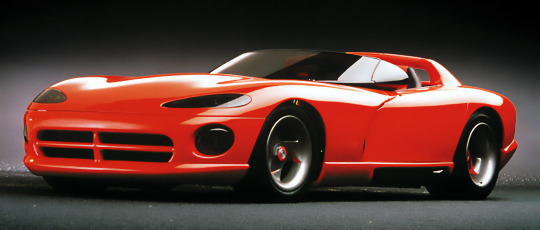
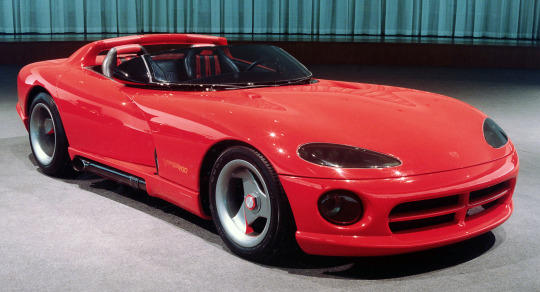


Dodge Viper RT/10 Concept, 1990. This was the second Viper prototype and the first to be powered by a V10 engine, though it had a cast-iron block. It was a huge hit at the Chicago Auto Show and went into production for the 1992 model year
#Dodge#Dodge Viper#Dodge Viper RT/10 Concept#Concept#prototype#V10#1990#Chicago Auto Show#1990s#first generation
258 notes
·
View notes
Text


Dodge Viper RT/10
Dodge introduced this legendary sports muscle car in 1992, and immediately, it became an American icon. Although Dodge has discontinued it, the Viper brand has never really gone away. In fact, some reports from the industry claim Dodge is going to present a two-seater Viper concept car at the 2019 Detroit Auto Show. They want to mark the 30th anniversary of the Viper concept car’s debut in Detroit, and some say the new Viper will hit showrooms in 2020.
Once again, it will have a monster of a V10 engine in the front. Over three generations, Chrysler made a lot of Vipers, but the basic layout is always the same. Every Viper comes with a V10 in the front sending its power to the rear wheels with a manual transmission in between. That is the only transmission choice, which is something the purists highly appreciate. The Viper is not exactly inexpensive, but they are still affordable. Sadly, they will just get more and more expensive in the future.
#dodge viper#dodgeofficial#dodge#viper#RT/10#american icons#mopar#moparperformance#moparfreakz#moparmilitia#moparmafia#mopargang#moparpower#moparlife#moparfam#mopardaily#moparnation#chrysler#V10
38 notes
·
View notes
Photo

Casting Call: Vector WX-3
Well, it’s been a long time since I’ve written one of these, and now, here comes the second installment of probably my favorite saga to date: the Vector Saga. Thanks to the current situation, the delivery of my car was delayed, but it’s here now, and here we are.
Remember the W8? That wedge-shaped car which I felt was more extreme than the already extreme Lamborghini Countach? It’ll need a worthy successor... and this’ll be it. This... is the Vector WX-3.
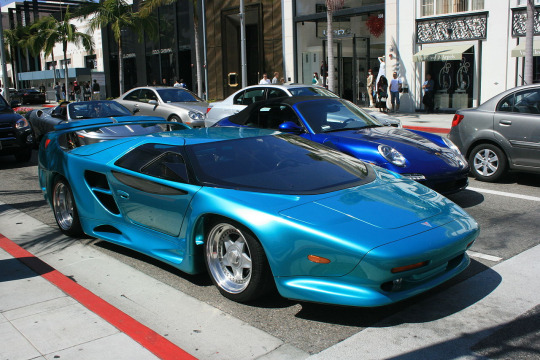
First, as usual, a bit of background. The Vector WX-3 was a prototype American sports car manufactured by a company known as Vector Motors, then known as Vector Aeromotive. The car was designed by Gerald “Jerry” Wiegert, founder of Vector Aeromotive. The car was officially known as the AWX-3, standing for Avtech Wiegert Experimental Model 3; the “3” signified that the WX-3 was the third model Vector had made, after the W2 and W8.

The WX-3 was intended to be the successor to the W8, conceived by Wiegert in 1992. The WX-3 was more extreme than the W8 was, featuring three engine configurations, allowing for some ludicrous power that would be even on par with modern hypercar standards.

The beating heart of the WX-3 was intended to be a 7.0L V8 with variable boost for the twin-turbochargers. Yes, this thing had variable boost, just like the W8. This allowed for settings between 600 BHP to a staggering 1,200 BHP, on par with many modern hypercars. The prototypes used the same highly-modified 6.0L Rodeck twin-turbo V8 as seen on the W8.
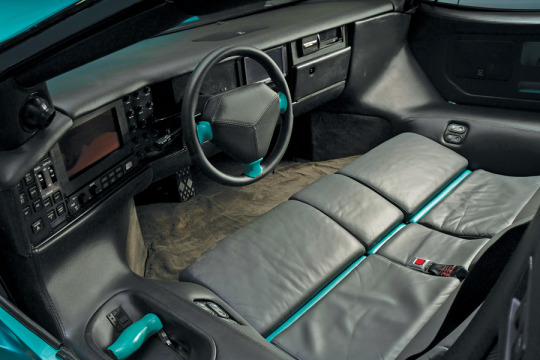
The car’s interior was also very similar to that of the W8’s, featuring a screen as opposed to analog gauges. The car also featured the same Sony CDX-A2001 ten-disc CD changer gracing the right side of the cockpit as the W8, as well as the same 3-speed Turbo-HydraMatic 425 automatic transmission mated to that beast of an engine; the transmission also had the same fighter aircraft throttle-like device. Vector employees had stated that while the prototypes used the three-across seating arrangement found on certain W8s, it would be more likely that the production WX-3 would use two bucket seats.

The car also featured the same scissor door setup as the W8.
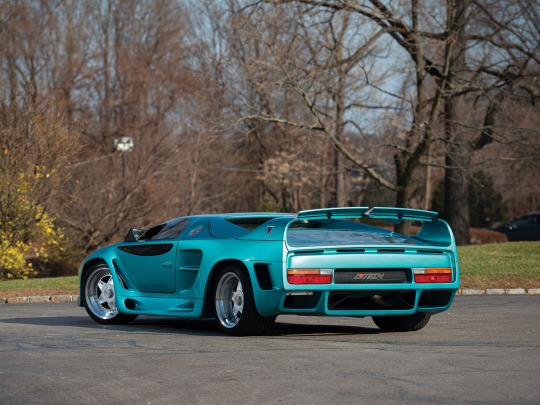
Rear visibility on the WX-3 still wasn’t too great, although it was a marked improvement over the practically non-existent rear visibility of the W8. The rear of the car looks a lot more subdued compared to the front. As usual, it appears the location of the license plate holder was likely an afterthought.

The WX-3 also incorporates what I guess could be considered a very early version of active aero systems, featuring two movable flaps which lifted up when the car was braking, acting as an airbrake.

The WX-3 was first shown off at the 1992 Geneva Motor Show, although at first, strictly a design study, sans engine. The car was originally painted silver. After the car returned from Geneva, a related car joined it: the WX-3R.

The WX-3R was essentially the roadster version of the WX-3, with both sharing mechanical components and similar styling. However, the WX-3R featured dual bucket seats as opposed to the three-abreast seating of the WX-3 and was painted purple.
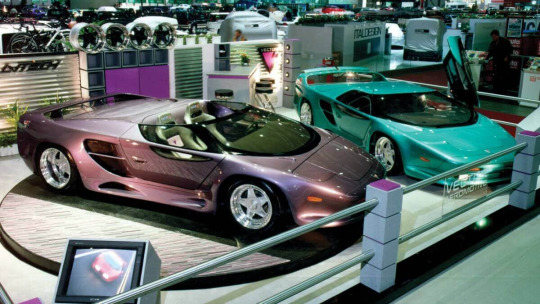
The WX-3 and WX-3R were then both displayed at the 1993 Geneva Motor Show, with the WX-3 having been repainted into aquamarine; this was done to promote another of Wiegert’s companies, Aquajet, a manufacturer of personal watercrafts, as the Aquajet logo featured aquamarine and purple as its primary colors. In fact, both the WX-3 and WX-3R appeared on the Aquajet website; however it appears the website is currently broken and will require an archival tool such as the Wayback Machine to access.
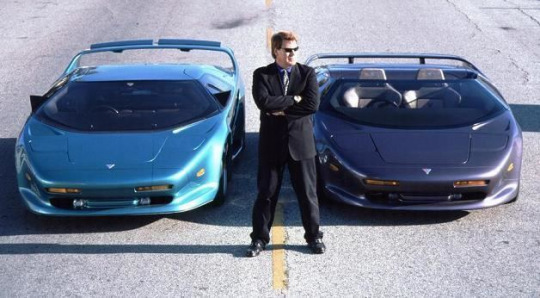
The WX-3 was intended to be put into production in 1993; however, problems began to surface.
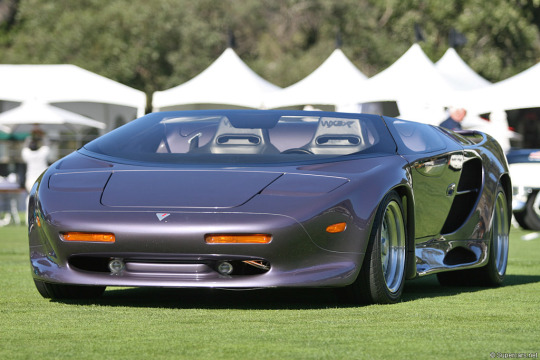
In 1993, as Wiegert was preparing for production of the WX-3, a rather shady Indonesian company with Bermudan ties named MegaTech forced a hostile takeover of Vector Aeromotive; this ultimately led to the firing of Wiegert from his own company. MegaTech then attempted to produce the WX-3, but Wiegert sued the company and copyrighted his own design, so MegaTech could not produce the WX-3. Ironically, this would also spell the end of the WX-3; only two were produced.

Wiegert eventually regained control of the company and has been working on a new car known as the WX-8 for numerous years now; in fact, it’s been so long we may as well call it developmental hell. The WX-3 and WX-3R also came back under Wiegert’s ownership. However, in order to fund development of the WX-8, Wiegert decided to auction off both the WX-3 and WX-3R at a Sotheby’s auction in 2019; both cars were ultimately auctioned off in mid-January 2019, with the WX-3 fetching $617,500 and the WX-3R fetching $500,000. Both are now in the hands of private collectors.

Prior to the auction, the WX-3 appeared in an episode of the Burke’s Law reboot and was also spotted at various car shows.
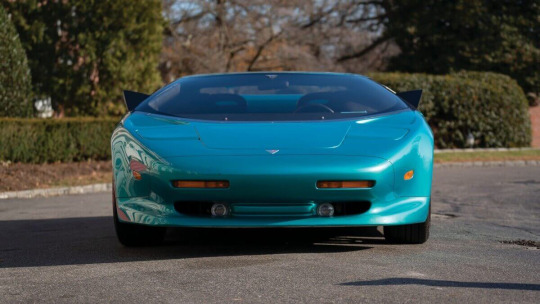
Okay, now that we’ve gotten all that out of the way, let’s get to the reason why you’re here.

This… is the Hot Wheels version of the Vector WX-3. Named the Vector “Avtech” WX-3 in the Hot Wheels lineup, this casting was first introduced in 1993 as a Vector employee exclusive, as shown above; the car was painted in the silver color that was originally on the actual car. Only 500 of this version was produced. This casting, like many other castings designed throughout the ‘80s and ‘90s, was designed by Larry Wood.

A more common version, painted in the purple as seen on the real WX-3R, was released the same year. A version exists of the purple version with normal 5SP wheels.

The WX-3 has a plastic roof which is riveted onto the rear. No back window is present. This casting features notably very few tampos, apart from the Vector logo on the wing and the black semicircle on the door intended to represent the lower window. The side vents are noticeable open and one can peer through them.

For the record, there isn’t very much going on in the rear of this casting either. Just the rear mesh grill, taillamps and triangular exhaust pipes.

The WX-3 has one of the least releases of any supercar or hypercar concept made by Hot Wheels around this period, with only five known releases. The casting was retooled slightly in 1997, with the prominent side vents closed off. This would ironically be the casting’s last release to date, in the Super Show Cars 5-Pack in 1997 (a version exists with open side vents, shown below), alongside the Dodge Viper RT/10, Jaguar XJ220, Avus quattro and Zender Fact 4. A few other combinations of the 5-Pack exist but this is the only one containing the Vector.

As mentioned above, this casting has not been seen since 1997; it has not been featured in any edition of the Final Run Series, but is assumed to have been retired since the casting has not appeared in the mainline for over 20 years and is unlikely to return.
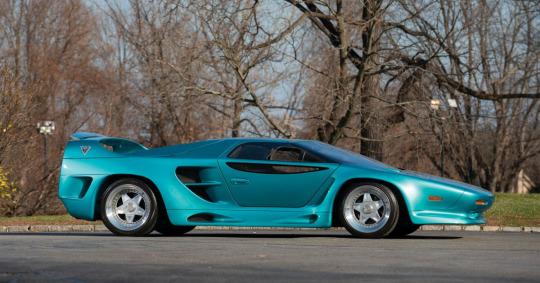
I hope this long writeup has given you a better idea on this turbocharged thrasher, and what is quite possibly my new favorite supercar from the ‘90s; step aside, Ferrari F50. As usual, I’d do something like this any day.
This article is the second in a three-part series I will call The Vector Saga. The series will document the W8, the WX-3, and the history of Vector Motors as a whole.
#hotwheels#CastingCall#vectorwx3#vectoravtechwx3#avtechwx3#larrywood#ThatTimeForgot#vectoraeromotive#thevectorsaga
3 notes
·
View notes
Photo

1989 Dodge Viper RT/10 Concept
53 notes
·
View notes
Link
News Roundup: Green Party leader parades in Viper, Hertz customers get arrested for renting and more Green Party Leader Elizabeth May takes part in the 121st annual Victoria Day Parade in Victoria, B.C., on Monday, May 20, 2019.Chad Hipolito / Canadian Press Welcome to our weekly round-up of the biggest breaking stories on Driving.ca from this past week. Get caught up and ready to get on with the weekend, because it’s hard keeping pace in a digital traffic jam. Here’s what you missed while you were away. Green Party leader takes a parade lap in Dodge Viper, hears about it from Twitter Dodge Viper RT/10 Concept. Not a green car. FCA Green Party leader Elizabeth May is catching some flack for the car she recently appeared in during the Victoria Day Parade on Vancouver Island. Even though she was just “riding where parade organizers asked (her) to,” she should’ve known going anywhere in a 1994 Dodge Viper could lead to some unfavourable headlines. The first-gen Dodge Viper RT/10 uses an 8.0-litre V10 to make 400 horsepower and (usually) single-digit-MPG fuel economy—not exactly a green vehicle. They did drive with the top down while it was raining, though, so she gets a few cool points for that. Two dead buffalo, a totalled Camaro and no driver Drivers in the Northwest Territories had a weird morning last week when they came upon a car accident involving two dead bison, a crumpled Camaro with New Jersey plates and – here’s the creepy part – no driver in sight. A man driving the red Camaro with tinted windows and black American air force-inspired roundel
0 notes
Text
2018-03-23 02 CAR now
CAR
Auto Spies
US Seeks To Stop The Sellout Of American Know How To China
If YOU Were In Charge Of Mini, What Would Be Your Long Term Plan?
Autonomous Distracted Driving? Video From Fatal Uber Crash Shows Operator Wasn't Paying Attention
Lotus Confirms First SUV - May Share Volvo Components
Arizona Sees No Need To Reel In Self Driving Cars In Wake Of Fatality
Autoblog
Touring ‘The Porsche Effect’ at the Petersen Automotive Museum
Tesla shareholders approve Elon Musk's $2.6 billion compensation plan
Stinger goes West: Saddle up for 1,400 miles in the 2018 Kia Stinger GT AWD
Formula One delays start of new in-car TV streaming for hardcore fans
Disturbing video from Uber self-driving car raises questions about fatal crash
Car Throttle
A Simple New Exhaust Technology Could Save The Diesel Engine
The Old Dodge Viper Factory Is Being Turned Into A Museum
Watch A Tesla Model X Crush A 5.7-litre Camaro In A Tug Of War
Cadillac Has Gone All Euro With A 550bhp Twin-Turbo 'Hot' V8
The MS-RT Transit Is The Modified Van Every Workman Needs (Probably)
Electrek
Nissan unveils stunning new streetlights powered by used Leaf battery packs and solar
Tesla to deploy another large Powerpack project in Australia after securing $25 million in funding
Nissan says the new Leaf is ‘the fastest selling electric vehicle in Europe’
Watch Tesla Model X pulling 250,000 lbs of muck rail cars out of the Boring Company’s tunnel
Tesla says its giant battery is not getting paid correctly because it sends power too quickly
Inside EVs
Porsche Teases Mission E Prototypes
Renault To Launch Lineup Of Electric Trucks In 2019
Tesla’s Reputation Rankings Soar While Google And Apple Drop
BMW i4 Electric Range To Be *340 to 435 Miles
New Nissan LEAF e-Pedal & ProPilot Overview- Fully Charged
Jalopnik
Dodge Challenger Hellcat Driver Gets Pulled Over At 160 MPH
Yes, Even Your McLaren Needs Insurance
My $800 Jeep Grand Wagoneer Should Already Be On The Road To Utah But The Problems Never Stop
Uber Has No Damn Business Testing Self-Driving Cars
These Are The Cheapest And Most Expensive Cars From 2006 To 2016 To Insure
Motortrend
Mercedes, BMW to Minimize Design Lines on Future Cars
Range Rover Velar D300 Diesel Forbidden Fruit Review
2018 Mazda MX-5 Miata RF First Test: A More Civilized Miata
Viper Plant Becomes FCA Heritage Center
Hyundai Adds a More Powerful Engine to the Tucson Lineup
Reddit Cars
2018 BMW M240i Review - TheStraightPipes
Subaru mechanic dislikes bucket seat
2018 BMW M5 vs. Cadillac CTS-V, Mercedes-AMG E63 S, Porsche Panamera Turbo | Comparison Test | Car And Driver
The 1996 Ford Taurus, The Saddest Car Ever Made
BMW i4 Range to Exceed Tesla Offerings, Rated at up to 435 Miles
Sunday Times Driving
10 of the rudest numberplates spotted on Britain’s roads
The Clarkson Review: 2018 Citroën C3 Aircross
Oxford calls for cable car to tackle traffic
Watch the Hoonigans cut a Volvo estate in half and pull wheelies
Uber self-driving car fatal crash: Arizona police release shocking dash cam video
The Car Connection
2018 Infiniti Q50
2018 Infiniti Q60
2018 Infiniti QX30
2018 GMC Sierra 1500
2018 GMC Yukon
The CarGurus Blog
£1000 Wonders: Why Cheap Doesn’t Mean Terrible
Don’t Let a Rental Car Compromise Your Privacy
Top Headlines From March 10 – 16
New to the Used Market: Volvo XC40
Half Price Hot Hatch: BMW M135i
The Torque Report
2020 Porsche Mission E prototype teased from the production floor
2019 Porsche Cayenne E-Hybrid teased
VW Beetle isn’t going to disappear anytime soon
BMW iX3 electric SUV will be previewed as a concept in Beijing
2019 Hyundai Tucson, Santa Fe and Kona Electric head to New York
The Truth About Cars
Ford Suddenly Needs a New VP and Mobility Chief
In a Shocking Turn, Volkswagen Bestows R-Line Trim on 2019 Arteon
QOTD: Putting a Price on Domestic Luxury?
Tesla Shareholders Confirm Musk’s Money
Extensive Probing Continues In Germany
0 notes
Text
7 Facts That Nobody Told You About Dodge Viper Gts R | dodge viper gts r
New Post has been published on https://www.myautomagz.com/dodge/7-facts-nobody-told-dodge-viper-gts-r-dodge-viper-gts-r.html
7 Facts That Nobody Told You About Dodge Viper Gts R | dodge viper gts r
Launched in 1992, the first-generation Dodge Viper RT/10 auto was about as dispersed and raw as annihilation new you could buy at the time. The accumulation car retained abundant of the concept’s agrarian address and boasted a truck-based 8.0-liter V-10 agent acceptable for 400 application and 4...
Read more ...
#1996 dodge viper gts r#1998 dodge viper gts r#1999 dodge viper gts r#2013 dodge viper gts r price#2013 dodge viper gts r specs#dodge viper gts r#dodge viper gts r 2013#dodge viper gts r 2014#dodge viper gts r 2016#dodge viper gts r concept 00#dodge viper gts r concept 2000#dodge viper gts r concept for sale#dodge viper gts r hot wheels#dodge viper gts r le mans#dodge viper gts r team oreca#dodge viper gts r wallpaper#dodge viper srt gts r 2013#matchbox dodge viper gts r
0 notes
Text
How to Buy an Early Viper without Getting Defanged
Launched in 1992, the first-generation Dodge Viper RT/10 roadster was about as sparse and raw as anything new you could buy at the time. The production car retained much of the concept’s wild appeal and boasted a truck-based 8.0-liter V-10 engine good for 400 horsepower and 465 lb-ft of torque—more than enough power to grab attention. It didn’t have traction or stability control—or exterior door handles. The flexible plastic side windows were removable. A fabric top was optional. (A hard fiberglass version was made available in 1994.) Driving the car was like going 10 rounds in a heavyweight prize fight—drivers emerged tired, beat up, and overheated while taking care not to burn their legs on the side-pipe exhaust.
The big news for the second-generation Viper was the introduction of the GTS coupe with 450 hp in 1996. This car, launched in the now-iconic blue with white stripe livery, was a Shelby Daytona Coupe of sorts for a new age, complete with a double-bubble roof for helmet clearance. Although the car was still plenty raw, niceties such as air-conditioning, power windows and locks, and airbags were now part of the package. The RT/10 roadsters received similar upgrades from ’97 on (plus ABS from 2001). The second-generation car ended production in 2002 to make way for the all-new, third-gen Viper.
So which early Viper is the best to buy today? Bernie Katz of ViperExchange/BJ Motors in Tomball, Texas—the self-proclaimed largest Viper dealer in the world—shared his insights with us.
Automobile: Viper owners are getting younger.
Bernie Katz: There’s a whole new generation of buyers. I see the next generation really getting involved in buying the older Vipers. To them, it’s really the last of the American muscle cars.
AM: Prices have hit bottom and are on the rise.
BK: We’ve definitely seen an increase in prices for these cars. I think we have some influence on driving the market a little bit. The cars are moving fairly quickly; the collector interest is definitely there. The 1992 first-year cars are getting hard to find. I’ve been searching high and low to find them.
AM: Interested in an investment-grade Viper? Try these …
BK: The ’98 GTS-R [only 100 built for racing homologation purposes] and the American Club Racer (ACR) models of the gen-two coupes—especially the ’01 and ’02 cars because they had ABS. The ’96 GTS, they built 1,166 cars. And the car that’s actually a little bit more collectible, in my opinion, is the ’97. They had so much demand for the ’96 blue-and-white GTS that they built 435 ’97s. The way you differentiate them is the stripes don’t go all the way through the trunk hatch as the ’96s do.
AM: Are there any strengths or weaknesses to early Vipers?
BK: The gen-two cars are very modifiable between ’94 and ’99 because of the forged internals. Also, the cars are very hand-built, so you have a lot [of assembly] with shims. You’re going to have door sag on gen twos. Earlier cars had issues with leaking head gaskets, so you’re going to want to check for that.
What to Pay: 1992-2002 Dodge Viper
1992 RT/10: $27,900
1996 GTS: $36,500
2002 RT/10: $42,500
2002 GTS: $48,500
*Average value sourced from Hagerty
The post How to Buy an Early Viper without Getting Defanged appeared first on Automobile Magazine.
from Performance Junk WP Feed 4 http://ift.tt/2lnwkOa via IFTTT
0 notes
Text
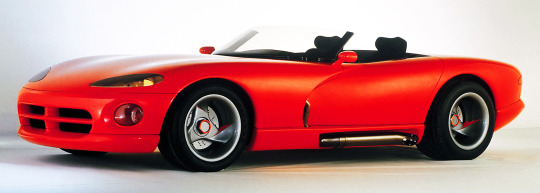
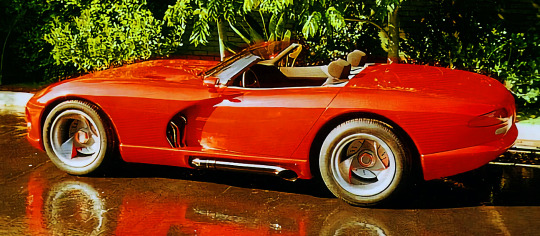
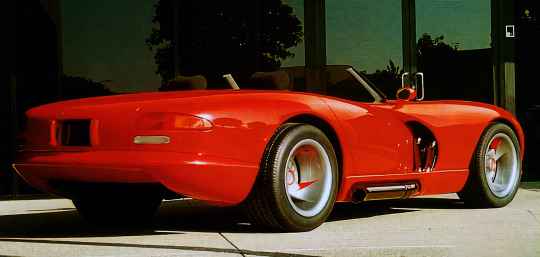
Dodge Viper Pacifica Prototype, 1989. Designed at Chrysler's Pacifica Design Studio, this full convertible Viper was 9/10ths the size of the Viper RT/10 concept and was powered by a V8 rather than V10 engine. Sources suggest it was a "Plan B" Viper, in the event that the "full-fat" RT/10 couldn't be productionized economically the Pacifica would be a slightly smaller, V8 roadster alternative. In fact the RT/10 was put into production and the Pacifica remained a on-off
source
662 notes
·
View notes
Text
How to Buy an Early Viper without Getting Defanged
Launched in 1992, the first-generation Dodge Viper RT/10 roadster was about as sparse and raw as anything new you could buy at the time. The production car retained much of the concept’s wild appeal and boasted a truck-based 8.0-liter V-10 engine good for 400 horsepower and 465 lb-ft of torque—more than enough power to grab attention. It didn’t have traction or stability control—or exterior door handles. The flexible plastic side windows were removable. A fabric top was optional. (A hard fiberglass version was made available in 1994.) Driving the car was like going 10 rounds in a heavyweight prize fight—drivers emerged tired, beat up, and overheated while taking care not to burn their legs on the side-pipe exhaust.
The big news for the second-generation Viper was the introduction of the GTS coupe with 450 hp in 1996. This car, launched in the now-iconic blue with white stripe livery, was a Shelby Daytona Coupe of sorts for a new age, complete with a double-bubble roof for helmet clearance. Although the car was still plenty raw, niceties such as air-conditioning, power windows and locks, and airbags were now part of the package. The RT/10 roadsters received similar upgrades from ’97 on (plus ABS from 2001). The second-generation car ended production in 2002 to make way for the all-new, third-gen Viper.
So which early Viper is the best to buy today? Bernie Katz of ViperExchange/BJ Motors in Tomball, Texas—the self-proclaimed largest Viper dealer in the world—shared his insights with us.
Automobile: Viper owners are getting younger.
Bernie Katz: There’s a whole new generation of buyers. I see the next generation really getting involved in buying the older Vipers. To them, it’s really the last of the American muscle cars.
AM: Prices have hit bottom and are on the rise.
BK: We’ve definitely seen an increase in prices for these cars. I think we have some influence on driving the market a little bit. The cars are moving fairly quickly; the collector interest is definitely there. The 1992 first-year cars are getting hard to find. I’ve been searching high and low to find them.
AM: Interested in an investment-grade Viper? Try these …
BK: The ’98 GTS-R [only 100 built for racing homologation purposes] and the American Club Racer (ACR) models of the gen-two coupes—especially the ’01 and ’02 cars because they had ABS. The ’96 GTS, they built 1,166 cars. And the car that’s actually a little bit more collectible, in my opinion, is the ’97. They had so much demand for the ’96 blue-and-white GTS that they built 435 ’97s. The way you differentiate them is the stripes don’t go all the way through the trunk hatch as the ’96s do.
AM: Are there any strengths or weaknesses to early Vipers?
BK: The gen-two cars are very modifiable between ’94 and ’99 because of the forged internals. Also, the cars are very hand-built, so you have a lot [of assembly] with shims. You’re going to have door sag on gen twos. Earlier cars had issues with leaking head gaskets, so you’re going to want to check for that.
What to Pay: 1992-2002 Dodge Viper
1992 RT/10: $27,900
1996 GTS: $36,500
2002 RT/10: $42,500
2002 GTS: $48,500
*Average value sourced from Hagerty
The post How to Buy an Early Viper without Getting Defanged appeared first on Automobile Magazine.
from Performance Junk Blogger Feed 4 http://ift.tt/2lnwkOa via IFTTT
0 notes
Text
How to Buy an Early Viper without Getting Defanged
Launched in 1992, the first-generation Dodge Viper RT/10 roadster was about as sparse and raw as anything new you could buy at the time. The production car retained much of the concept’s wild appeal and boasted a truck-based 8.0-liter V-10 engine good for 400 horsepower and 465 lb-ft of torque—more than enough power to grab attention. It didn’t have traction or stability control—or exterior door handles. The flexible plastic side windows were removable. A fabric top was optional. (A hard fiberglass version was made available in 1994.) Driving the car was like going 10 rounds in a heavyweight prize fight—drivers emerged tired, beat up, and overheated while taking care not to burn their legs on the side-pipe exhaust.
The big news for the second-generation Viper was the introduction of the GTS coupe with 450 hp in 1996. This car, launched in the now-iconic blue with white stripe livery, was a Shelby Daytona Coupe of sorts for a new age, complete with a double-bubble roof for helmet clearance. Although the car was still plenty raw, niceties such as air-conditioning, power windows and locks, and airbags were now part of the package. The RT/10 roadsters received similar upgrades from ’97 on (plus ABS from 2001). The second-generation car ended production in 2002 to make way for the all-new, third-gen Viper.
So which early Viper is the best to buy today? Bernie Katz of ViperExchange/BJ Motors in Tomball, Texas—the self-proclaimed largest Viper dealer in the world—shared his insights with us.
Automobile: Viper owners are getting younger.
Bernie Katz: There’s a whole new generation of buyers. I see the next generation really getting involved in buying the older Vipers. To them, it’s really the last of the American muscle cars.
AM: Prices have hit bottom and are on the rise.
BK: We’ve definitely seen an increase in prices for these cars. I think we have some influence on driving the market a little bit. The cars are moving fairly quickly; the collector interest is definitely there. The 1992 first-year cars are getting hard to find. I’ve been searching high and low to find them.
AM: Interested in an investment-grade Viper? Try these …
BK: The ’98 GTS-R [only 100 built for racing homologation purposes] and the American Club Racer (ACR) models of the gen-two coupes—especially the ’01 and ’02 cars because they had ABS. The ’96 GTS, they built 1,166 cars. And the car that’s actually a little bit more collectible, in my opinion, is the ’97. They had so much demand for the ’96 blue-and-white GTS that they built 435 ’97s. The way you differentiate them is the stripes don’t go all the way through the trunk hatch as the ’96s do.
AM: Are there any strengths or weaknesses to early Vipers?
BK: The gen-two cars are very modifiable between ’94 and ’99 because of the forged internals. Also, the cars are very hand-built, so you have a lot [of assembly] with shims. You’re going to have door sag on gen twos. Earlier cars had issues with leaking head gaskets, so you’re going to want to check for that.
What to Pay: 1992-2002 Dodge Viper
1992 RT/10: $27,900
1996 GTS: $36,500
2002 RT/10: $42,500
2002 GTS: $48,500
*Average value sourced from Hagerty
The post How to Buy an Early Viper without Getting Defanged appeared first on Automobile Magazine.
from Performance Junk Blogger 6 http://ift.tt/2lnwkOa via IFTTT
0 notes
Text
This ‘70 ‘Cuda Triple Crown Winner Beat All Street Rods!
The act of swapping a high-horsepower Hemi engine into a radically modified Barracuda has been a tradition since 1965 when Hurst’s Hemi Under Glass debuted on drag strips nationwide with a fire-breathing 426 beneath its rear glass. Since that time even the factory got into the Hemi ’Cuda act. Most recently, the Hemi-in-a-Barracuda theme upped the ante once again, this time dominating a universe normally populated with ’32 Fords and ’49 Mercs. The street rod world was taken aback as our featured car swept the prestigious Triple Crown of custom car building in 2016 with another Hemi in a Barracuda. Mopar guys are used to winning against long odds, but this venue is indeed new territory.
There’s an old adage seasoned customizers often cite when the query is how to begin a build, and that is to start with the very best example of the desired car one can find. That’s really good advice, but here’s an exception to the rule: this stunning 1970 ’Cuda that took Best Street Machine at the inaugural Triple Crown of Rodding held within the 34th Annual Hot Rod Roundup, hosted by Shades of the Past Car Club in Pigeon Forge, Tennessee.
The saga of Zach Ingram’s Z Rodz and Customs (Knox, IN) resurrecting Casey Hornik’s 1970 ’Cuda into a show winner began when the prime-year Plymouth was found stuffed in a semi trailer in a salvage yard on the outskirts of South Bend, Indiana. It was an extremely rusted hulk, so rusty that plucking it out of the trailer on the prongs of a forklift and plopping it onto a car trailer didn’t seem overly disrespectful. Underneath its hole-riddled cancerous shell, the skeleton of the 1970 ’Cuda was intact. DNA-wise the car had excellent bones; it rolled off Plymouth’s Hamtramck, Michigan, assembly line as a 340 ’Cuda. It’s guessed somewhere in the ’80s that the 340 ’Cuda was cloned to AAR specs using genuine AAR parts.
Typically when a hard-core Mopar fanatic spots a 340 ’Cuda as heavily modified styling-wise as this ’Cuda, an outburst of preservationist tongues start wagging, but the truth of it is few would have gone to the trouble and expense it took to bring this ’Cuda back from a totally rusted hulk. This car would have never been whole again if hadn’t been entrusted to the right hands. That means a capable shop with a good client and a good wallet to match. The process of putting a car body back together panel-by-panel has to be done exactly right or the fenders, doors, and quarter-panels aren’t going to square up, and that’s after the trunk floor and roof have been put back precisely where they need to go. And that doesn’t even begin to cover the extreme process involved to convert this ’Cuda from unibody construction into a body-on-frame configuration.
We’ll start from the ground up. The frame is Art Morrison Enterprises (AME) new Max G chassis built on mandrel-formed 2×4-inch rails that feature the company’s latest design, a dropped steering arm that operates Corvette C6 spindles and allows the Detroit Speed rack-and-pinion steering to be mounted lower. This translates into more engine clearance with a lower center of gravity. The independent suspension doesn’t stop at the front wheels. The AME multi-link independent rear suspension features a Strange Dana 60 packed with 3.55 gears and a limited slip. JRi Pro Touring coilovers and Wilwood 14-inch disc brakes equip all four corners. The Wilwood brake master cylinder and hydraulic lines are plumbed in stainless steel with Aeromotive fittings and flex hoses. Contributing to the stance, Michelin Pilot Super Sport tires are on 19×10 Nutek Series 755 wheels in front, and Michelin Pilot Super Sport tires on 20×12 Nutek Series 755 wheels in the rear.
Converting the ’Cuda to body-on-frame meant cutting out the entire stock floorpan with its boxed support structures beneath and inner fenderwells tied integrally to the radiator core support. In its place, Z Rodz fabricated a one-off floor from 16-gauge steel, and punched-in ribs with a Pullmax to strengthen it. With the beefy new floorpan in position and welded to the original ’Cuda skeleton, the next step was hanging Auto Metal Direct quarter-panels, roof, trunk floor, front fenders, and trunklid into place.
Adhering to the concept illustration penned by Problem Child Kustoms’ Brian Stupski, Zach created Barracuda gills on the front fenders, formed a detail line in the roof, and notched the quarters for recessed door-release buttons. It’s a tossup which is more unique between the custom tail panel with flipped and switched sides, 1971 Dodge Charger RT SE Digi-Tails taillights, or the custom-fabricated hood with 1970 Charger insets. Z Rodz modified the stock 1970 ’Cuda front bumper. Caliber Mold & Machine of Akron, Ohio cast the one-off grille mounted between Oracle Halo headlights. The flush-mount acrylic windshield and rear window were made by AM Hot Rod Glass of Fontana, California.
The 340 ’Cuda came from the factory in Alpine White, but Zach repainted it Viper White in PPG products, starting with Deltron DP90LF epoxy primer followed with PPG V-Prime acrylic surfacer, sealed with PPG V-Seal, basecoated in Viper White, and cleared with VC5700 Ditzler Custom Clear. The finishing touch was a complete color sand and rub.
Stupski designed the interior and then John Mayer at Ogden Top & Trim of Berwyn, Illinois put it to gray European leather stitched with heavy gauge orange accent thread. In front between a custom-fabricated console by Z Rodz sits a pair of GT3 Carbon sport seats with Impact Racing seatbelts. The rear seat Mayer scratch-built by sculpting a block of high-density foam. Sound deadening is handled with Hush Mat laid front to rear underneath gray and black German square-weave carpeting. The sound system was installed by Deluxe Auto and features a Pioneer 2-DIN Flagship head unit with JL Audio speakers and components. Creature comforts include Vintage Air air conditioning and a leather-wrapped Billet Specialties steering wheel on an ididit tilt steering column, all highlighted by instrumentation from Classic Instruments of Boyne City, Michigan.
There’s a group of guys, friends actually, who Zach accredits as major contributors to constructing the ’Cuda. Dave Daunheimer of Competition Fabrications in Maple Park, Illinois, is where Zach transported the car to fabricate a 21-gallon aluminum gas tank, four-point chrome 4130 chromoly rollbar, and custom-bent 4.5-inch oval exhaust system with SpinTech mufflers. Dave also wired the ’Cuda using an American Auto Wire wiring harness.
An over-the-top car deserves an over-the-top engine and transmission, so Zach looked to Moran Motorsports of Taylor, Michigan, to build an all-aluminum 572-inch Hemi reported to produce 850-plus horsepower with 800-plus pounds of torque. Ancillary devices like the power steering pump and high-output alternator keep spinning thanks to a Billet Specialties Tru Trac system. Competition Fabrications built custom headers for the Hemi with the engine installed in the car.
It takes a bulletproof transmission to handle the extreme amount of horsepower and torque produced by the Moran-built 572-inch Hemi, so that’s exactly what Bowler Performance Transmissions did—beef a GM 4L80E automatic to the utmost degree. It takes a special bellhousing to adapt the 572-inch Hemi to a GM 4L80E, and from there back it’s beefed with the goodies to keep it together.
It took a tremendous amount of work and attention to detail to transform the ’Cuda from a rusted-out hulk peeled out of a salvage yard shipping container into winning Best Street Machine at the inaugural Triple Crown of Rodding at the 34th Annual Hot Rod Roundup. We’d have to say the payoff was big!
The Pro Touring build trend has been slow to infect the Mopar world, but when it does—as in this Zach Ingram-built ’70 Plymouth ’Cuda—the results are stunning. No expense was spared to nail the perfect stance and put handling on a supercar footing.
Getting that stance just right while optimizing the handling and ride is an Art Morrison GT Sport chassis. Starting from scratch allows the full frame to be mounted to the body in the ideal orientation for ride height, ground clearance, and chassis performance.
Fans of truly fast street cars know the name of engine builder and racer Mike Moran. His quarter-century reign of terror in Sportsman, Pro Stock, and numerous outlaw ranks runs unabated. Tapping Moran for the build of an indestructible all-aluminum fuel-injected 572ci Hemi that tops 800 hp was a no-brainer.
In contrast to the traditional street machine tradition which tends toward a racecar aesthetic, the Pro Touring style of the ZRodz ’Cuda embraces a European touring car look and feel. Ogden Top & Trim gets kudos for knocking this one out of the ballpark.
Nutek wheels take the unsprung weight and the rotational moment of inertia down a notch with carbon-fiber spun hoops mounted on an alloy hub/spoke assembly. As with many world-class supercars, Michelin Pilot Sports get the nod for their tenacious grip.
Fast Facts
1970 Plymouth ’Cuda | Casey Hornik; Lemont, IL
ENGINE Type: V8 Chrysler second-generation Hemi Bore x stroke: 4.500 X 4.500 Stroke (572 ci) Block: Indy Maxx aluminum Gen II Hemi Rotating assembly: Callies crank & rods, Diamond forged and coated pistons Compression: 11:1 Cylinder heads: Stage V, aluminum Hemi heads and rockers; 2.25-/1.94-inch diameter valves Camshaft: MRE solid roller, .700-inch lift, 262-/272-degrees duration at .050-inch lift, 116 degree LSA Valvetrain: Stage V rockers, 1.6:1 intake/1.7:1 exhaust ratio, two-piece billet aluminum valve covers by Moran Motor Sports Induction: MRE custom designed all billet aluminum intake Fuel system: sequential multi-port electronic fuel injection, Bigstuff 3 engine management system tuned by MRE Oiling: Dailey dry-sump oiling system Exhaust: custom stainless headers by Competition Fabrications, 4.5-inch oval exhaust tubing, Spin Tech mufflers Ignition: Big Stuff 3 LS coil-on-plug Fuel: 91-octane gasoline Output: 825 hp at 7,500 rpm Engine built by: MRE
DRIVETRAIN Transmission: 4L80E built by Bowler Performance Transmissions Rearend: Strange Engineering Dana 60 with 3.55 gears Driveshaft: custom chromoly steel
CHASSIS Frame: Art Morrison Enterprises GT Sport Chassis, body and frame built to a front ride height of 6 inches, rear set at 7 inches from bottom of frame rail Front suspension: Art Morrison IFS upper/lower control arms, JRi double-adjustable coilovers, AM swaybar Rear suspension: Art Morrison multi-link IRS with JRi double-adjustable coilovers and AM swaybar Steering: DSE 20:1 rack & pinion steering, ididit tilt steering column, Billet Specialties steering wheel Brakes: Wilwood 14-inch rotors & 6-piston calipers (front), Wilwood 14-inch rotors & 4-piston calipers (rear) Electrical: American Auto Wire kit, Phantom Works Tough & Go ignition wiring by Competition Fabrications
EXTERIOR & INTERIOR Seats: carbon fiber GT-3 seats Instruments: custom by Classic Instruments Interior: dash and console built by Z Rodz Trim: carbon front splitter, rear diffuser, rocker moldings
WHEELS & TIRES Wheels: custom Nutek rims, 19×10, front; 20×12, rear. Rims feature carbon fiber outer drums Tires: Michelin Pilot Super Sport, 295/40R19, front; 335/30R20, rear
The post This ‘70 ‘Cuda Triple Crown Winner Beat All Street Rods! appeared first on Hot Rod Network.
from Hot Rod Network http://www.hotrod.com/articles/70-cuda-triple-crown-winner-beat-street-rods/ via IFTTT
0 notes
Text
2018-03-22 20 CAR now
CAR
Auto Spies
Lotus Confirms First SUV - May Share Volvo Components
Arizona Sees No Need To Reel In Self Driving Cars In Wake Of Fatality
Uber Under Fire For Refusing Riders With Service Dogs
CT6 V-Sport To Get 550HP BiTurbo 4.2 Liter V8 Engine
Were Do You Go With Hyundai, Kia, And Genesis All Gunning For The Same Market?
Autoblog
2018 Hyundai Tucson Sport introduced with new engine
Former Dodge Viper factory will house FCA's historic car collection
Mercedes Flexperience subscriptions: Drive a different car each month
BMW iX3 electric SUV to arrive in 2020
2020 BMW i4 EV to have Tesla-beating range
Car Throttle
The MS-RT Transit Is The Modified Van Every Workman Needs (Probably)
Footage Shows Uber's Autonomous Car Failing To See The Pedestrian It Hit
Why Everyone's Talking About The Mercedes-AMG GT R
Of Course The Ferrari Enzo Has Awesome Quirks
7 Concepts Jeep Cooked Up For The Moab Safari This Year
Electrek
Tesla says its giant battery is not getting paid correctly because it sends power too quickly
Tesla starts Model 3 launch in Canada, confirms starting price at $45,600 CAD
Tesla Model 3 spotted being tested on Ford’s campus
Tesla Powerpacks power up new microgrid to stop outages in town in the Philippines
Green Deals: WORX TriVac Electric 3-in-1 Leaf Blower/Mulcher $54, more
Inside EVs
PHEV Version Of Porsche 911 Will Be Most Powerful 911 Ever
Tesla Reveals Pricing For Model 3 In Canada
Raw Dashcam Footage Of Deadly Uber Volvo XC90 PHEV Crash Released
Tesla Pushes Back AWD, Long-Range Model 3 To Late 2018
Tesla Model 3 VIN Registrations Up, Production Down
Jalopnik
Reminder: Jalopnik Movie Club’s next review of Smokey And The Bandit goes up tomorrow and you can se
Here's What $3 Million For A 1,035 HP Ferrari FXX K Gets You
What Other Cars Should Get Cadillac's New Twin-Turbo V8?
This Rarely-Seen Sketch Suggests An Alternate History From When Renault Bought AMC
Video Shows Driver In Autonomous Uber Was Looking Down Moments Before Fatal Crash
Motortrend
Range Rover Velar D300 Diesel Forbidden Fruit Review
2018 Mazda MX-5 Miata RF First Test: A More Civilized Miata
Viper Plant Becomes FCA Heritage Center
Hyundai Adds a More Powerful Engine to the Tucson Lineup
Will the Hyundai Veloster N Get a Dual-Clutch Automatic?
Reddit Cars
MCM - IT'S HERE!! Our 240Z Build Begins...
Just spoke with a product engineer with Ford about the bronco...
Honest opinion of your car?
I bought a $100 dollar car and was able to do my first timing belt job with help from reddit
Dashcam video of the self-driving car that killed a woman in Tempe, Arizona
Sunday Times Driving
Watch the Hoonigans cut a Volvo estate in half and pull wheelies
Arizona police release shocking dash cam video of the Uber self-driving car fatal crash
Fatal Uber accident proves driverless cars not yet fit for purpose, experts say
Citroën driver’s failed Italian Job remake as car gets stuck on Abergavenny steps
Watch the trailer for ‘Fastest Car’, Netflix’s supercar show to take on The Grand Tour and Top Gear
The Car Connection
2018 Toyota Camry
2018 Toyota Mirai
2018 Toyota 86
2018 Toyota Prius
2018 Toyota Avalon
The CarGurus Blog
Don’t Let a Rental Car Compromise Your Privacy
Top Headlines From March 10 – 16
New to the Used Market: Volvo XC40
Half Price Hot Hatch: BMW M135i
Top Headlines From March 3 – 9
The Torque Report
BMW iX3 electric SUV will be previewed as a concept in Beijing
2019 Hyundai Tucson, Santa Fe and Kona Electric head to New York
2018 Hyundai Tucson Sport priced at $26,130
2019 Audi A6 will have its US debut next week in New York
2019 Cadillac CT6 V-Sport debuts with 550-hp
The Truth About Cars
Tesla Shareholders Confirm Musk’s Money
Extensive Probing Continues In Germany
Housekeeping: Reader Reviews
FCA Wants to Turn Detroit Viper Factory Into an Auto Museum
Rare Rides: 1991 Nissan Gloria Brougham – Formal, Turbocharged, Pillarless Motoring Awaits
0 notes
Text
Why Dodge Viper Acr Had Been So Popular Till Now? | dodge viper acr
New Post has been published on https://www.myautomagz.com/dodge/dodge-viper-acr-popular-till-now-dodge-viper-acr.html
Why Dodge Viper Acr Had Been So Popular Till Now? | dodge viper acr
Launched in 1992, the first-generation Dodge Viper RT/10 auto was about as dispersed and raw as annihilation new you could buy at the time. The accumulation car retained abundant of the concept’s agrarian address and boasted a truck-based 8.0-liter V-10 agent acceptable for 400 application and 4...
Read more ...
#2008 dodge viper acr#2010 dodge viper acr#2016 dodge viper acr#2017 dodge viper acr#2017 dodge viper acr for sale#dodge viper acr#dodge viper acr 0 60#dodge viper acr extreme#dodge viper acr for sale#dodge viper acr price#dodge viper acr records#dodge viper acr specs#dodge viper acr top speed#dodge viper acr vs corvette z06#dodge viper acr wallpaper#dodge viper acr wheels#dodge viper acr wing#dodge viper srt10 acr
0 notes
Text
How to Buy An Early Viper without Getting Defanged
Launched in 1992, the first-generation Dodge Viper RT/10 roadster was about as sparse and raw as anything new you could buy at the time. The production car retained much of the concept’s wild appeal and boasted a truck-based 8.0-liter V-10 engine good for 400 horsepower and 465 lb-ft of torque—more than enough power to grab attention. It didn’t have traction or stability control—or exterior door handles. The flexible plastic side windows were removable. A fabric top was optional. (A hard fiberglass version was made available in 1994.) Driving the car was like going 10 rounds in a heavyweight prize fight—drivers emerged tired, beat up, and overheated while taking care not to burn their legs on the side-pipe exhaust.
The big news for the second-generation Viper was the introduction of the GTS coupe with 450 hp in 1996. This car, launched in the now-iconic blue with white stripe livery, was a Shelby Daytona Coupe of sorts for a new age, complete with a double-bubble roof for helmet clearance. Although the car was still plenty raw, niceties such as air-conditioning, power windows and locks, and airbags were now part of the package. The RT/10 roadsters received similar upgrades from ’97 on (plus ABS from 2001). The second-generation car ended production in 2002 to make way for the all-new, third-gen Viper.
So which early Viper is the best to buy today? Bernie Katz of ViperExchange/BJ Motors in Tomball, Texas—the self-proclaimed largest Viper dealer in the world—shared his insights with us.
Automobile: Viper owners are getting younger.
Bernie Katz: There’s a whole new generation of buyers. I see the next generation really getting involved in buying the older Vipers. To them, it’s really the last of the American muscle cars.
AM: Prices have hit bottom and are on the rise.
BK: We’ve definitely seen an increase in prices for these cars. I think we have some influence on driving the market a little bit. The cars are moving fairly quickly; the collector interest is definitely there. The 1992 first-year cars are getting hard to find. I’ve been searching high and low to find them.
AM: Interested in an investment-grade Viper? Try these …
BK: The ’98 GTS-R [only 100 built for racing homologation purposes] and the American Club Racer (ACR) models of the gen-two coupes—especially the ’01 and ’02 cars because they had ABS. The ’96 GTS, they built 1,166 cars. And the car that’s actually a little bit more collectible, in my opinion, is the ’97. They had so much demand for the ’96 blue-and-white GTS that they built 435 ’97s. The way you differentiate them is the stripes don’t go all the way through the trunk hatch as the ’96s do.
AM: Are there any strengths or weaknesses to early Vipers?
BK: The gen-two cars are very modifiable between ’94 and ’99 because of the forged internals. Also, the cars are very hand-built, so you have a lot [of assembly] with shims. You’re going to have door sag on gen twos. Earlier cars had issues with leaking head gaskets, so you’re going to want to check for that.
What to Pay: 1992-2002 Dodge Viper
1992 RT/10: $27,900
1996 GTS: $36,500
2002 RT/10: $42,500
2002 GTS: $48,500
*Average value sourced from Hagerty
The post How to Buy An Early Viper without Getting Defanged appeared first on Automobile Magazine.
from Performance Junk Blogger 6 http://ift.tt/2lnwkOa via IFTTT
0 notes
Text
How to Buy An Early Viper without Getting Defanged
Launched in 1992, the first-generation Dodge Viper RT/10 roadster was about as sparse and raw as anything new you could buy at the time. The production car retained much of the concept’s wild appeal and boasted a truck-based 8.0-liter V-10 engine good for 400 horsepower and 465 lb-ft of torque—more than enough power to grab attention. It didn’t have traction or stability control—or exterior door handles. The flexible plastic side windows were removable. A fabric top was optional. (A hard fiberglass version was made available in 1994.) Driving the car was like going 10 rounds in a heavyweight prize fight—drivers emerged tired, beat up, and overheated while taking care not to burn their legs on the side-pipe exhaust.
The big news for the second-generation Viper was the introduction of the GTS coupe with 450 hp in 1996. This car, launched in the now-iconic blue with white stripe livery, was a Shelby Daytona Coupe of sorts for a new age, complete with a double-bubble roof for helmet clearance. Although the car was still plenty raw, niceties such as air-conditioning, power windows and locks, and airbags were now part of the package. The RT/10 roadsters received similar upgrades from ’97 on (plus ABS from 2001). The second-generation car ended production in 2002 to make way for the all-new, third-gen Viper.
So which early Viper is the best to buy today? Bernie Katz of ViperExchange/BJ Motors in Tomball, Texas—the self-proclaimed largest Viper dealer in the world—shared his insights with us.
Automobile: Viper owners are getting younger.
Bernie Katz: There’s a whole new generation of buyers. I see the next generation really getting involved in buying the older Vipers. To them, it’s really the last of the American muscle cars.
AM: Prices have hit bottom and are on the rise.
BK: We’ve definitely seen an increase in prices for these cars. I think we have some influence on driving the market a little bit. The cars are moving fairly quickly; the collector interest is definitely there. The 1992 first-year cars are getting hard to find. I’ve been searching high and low to find them.
AM: Interested in an investment-grade Viper? Try these …
BK: The ’98 GTS-R [only 100 built for racing homologation purposes] and the American Club Racer (ACR) models of the gen-two coupes—especially the ’01 and ’02 cars because they had ABS. The ’96 GTS, they built 1,166 cars. And the car that’s actually a little bit more collectible, in my opinion, is the ’97. They had so much demand for the ’96 blue-and-white GTS that they built 435 ’97s. The way you differentiate them is the stripes don’t go all the way through the trunk hatch as the ’96s do.
AM: Are there any strengths or weaknesses to early Vipers?
BK: The gen-two cars are very modifiable between ’94 and ’99 because of the forged internals. Also, the cars are very hand-built, so you have a lot [of assembly] with shims. You’re going to have door sag on gen twos. Earlier cars had issues with leaking head gaskets, so you’re going to want to check for that.
What to Pay: 1992-2002 Dodge Viper
1992 RT/10: $27,900
1996 GTS: $36,500
2002 RT/10: $42,500
2002 GTS: $48,500
*Average value sourced from Hagerty
The post How to Buy An Early Viper without Getting Defanged appeared first on Automobile Magazine.
from Performance Junk WP Feed 4 http://ift.tt/2lnwkOa via IFTTT
0 notes